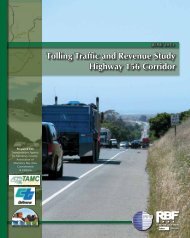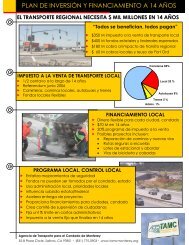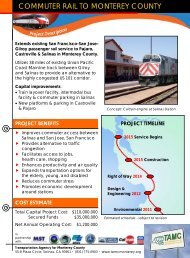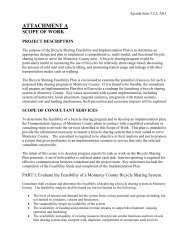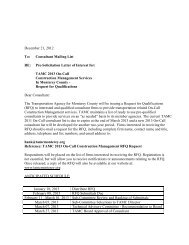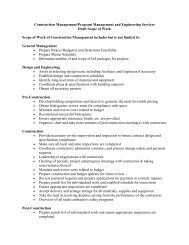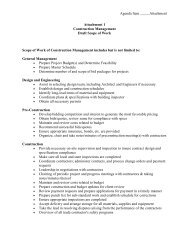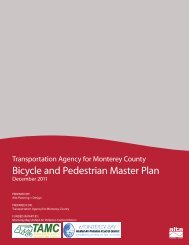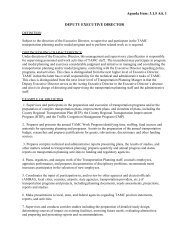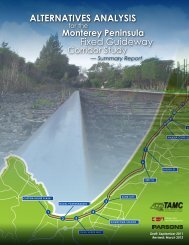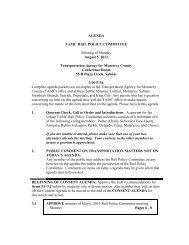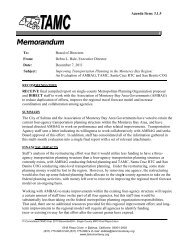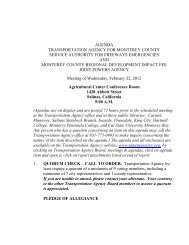Commuter Rail Extension Alternatives Analysis - Transportation ...
Commuter Rail Extension Alternatives Analysis - Transportation ...
Commuter Rail Extension Alternatives Analysis - Transportation ...
You also want an ePaper? Increase the reach of your titles
YUMPU automatically turns print PDFs into web optimized ePapers that Google loves.
CALTRAIN EXTENSION TO MONTEREY COUNTYALTERNATIVES ANALYSISSummary of BenefitsThe Caltrain <strong>Extension</strong> Alternative and Express Bus Alternative will both produce net savings in traveltime, crashes, and vehicle operating expense. These findings are summarized in Table 8-31 and aresorted by benefit type. The benefits monetized in Table 8-31 are expressed as positive dollars, whilecosts are expressed as (negative) dollars. Table 8-31 demonstrates that the benefits of the Caltrain<strong>Extension</strong> Alternative exceed the benefits of the Express Bus Alternative in both 2010 and 2030.Table 8-31Summary of Caltrain <strong>Extension</strong> and Express Bus Alternative Benefits2010 2030Benefit Type Caltrain Express Bus Caltrain Express BusUser BenefitsIn-vehicle travel time (Method 3) $ 252,032 $ 252,032 $ 6,985,931 $ 4,160,454Fuel costs 4,499,622 4,499,622 8,631,039 8,631,039Non-fuel operating savings 1,925,316 1,925,316 3,693,083 3,693,083Transit user fees (3,310,612) (3,310,612) (6,320,790) (6,320,790)Internal accident costs or savings— 3,144,040 3,144,040 6,027,934 6,027,934Highway(150,545) (893,907) (304,004) (1,698,612)Revenue Transfers (fuel taxes) (893,915) (893,915) (1,714,681) (1,714,681)Reduction in External CostsEmissions 14,361 (105,368) (136,415) (381,210)Highway accidents 554,830 554,830 1,063,753 1,063,753Transit accidents (14,406) (148,306) (28,744) (284,432)Net Public Operating Costs (1,175,068) (5,256,095) (2,393,619) (10,812,623)Total $4,845,655 ($232,363) $15,503,487 $2,363,915Life-Cycle Benefits and CostsThe Caltrain <strong>Extension</strong> and Express Bus alternatives are assumed to be implemented by 2010, withthe initiation of service occurring in 2011. The Caltrain <strong>Extension</strong> Alternative assumes that rollingstock for the JPB Caltrain fleet will be purchased in 2010 14 . The Express Bus Alternative assumesthat rolling stock will be purchased in 2010 and at five-year increments thereafter, to increase thefleet size from 30 to 60 vehicles over time. Replacement express bus vehicles are assumed to berequired at 12-year intervals. All FY 2007 dollar capital costs reported in Chapter 6 have beenassumed to reflect year end 2006 dollars.Tables 8-32 and 8-33 report comparisons of life-cycle benefits and costs for the Caltrain <strong>Extension</strong>and Express Bus alternatives, with each compared to the No Build Alternative. Total benefits and14Additional trainset capacity (additions of coaches to consists) required to accommodate riders boarding/deboarding in Monterey Countyare assumed to be addressed through Federal Transit Administration grant requests, with TAMC providing the local funding match contribution.Acquisition of rolling stock to accommodate the initial (two round trip) service plan for extending Caltrain to Salinas has not beenidentified as a near-term requirement by this <strong>Alternatives</strong> <strong>Analysis</strong>. At some time in the future, TAMC anticipates the need to participate inJPB’s rolling stock acquisition program. For the purpose of the <strong>Alternatives</strong> <strong>Analysis</strong> Study, the Caltrain <strong>Extension</strong> Alternative assumesthe acquisition of four bi-level passenger coaches, one for each of the trainsets operating to/from Salinas. This rolling stock may not berequired to accommodate peak passenger loads. The capital cost of this equipment is included as a risk element for comparison with theExpress Bus Alternative.parsons CHAPTER 8: EVALUATION OF ALTERNATIVES 196



